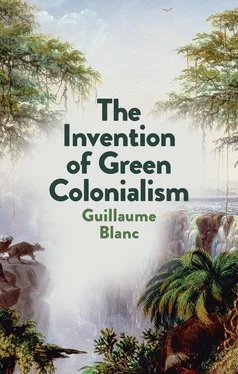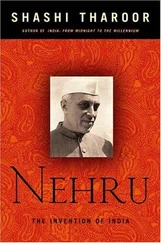Every effort has been made to trace all copyright holders, but if any have been overlooked the publisher will be pleased to include any necessary credits in any subsequent reprint or edition.
For further information on Polity, visit our website: politybooks.com
Preface to the English Edition History as a Starting Point
The Invention of Green Colonialism . By virtue of its title, as soon as it was published, this book was associated with postcolonial studies, even with ‘decolonial’ thinking. These fields of study have of course influenced my work, but what I wanted first and foremost was to write a book focusing on environmental history. With this discipline, ‘we can create a more usable past, one more relevant to the everyday lives of people today’, as Ted Steinberg puts it. And to do that, the American historian tells us, we need to re-establish ‘the way power operates through and across landscape’. 1
Still in North America, this time in Canada, Stéphane Castonguay explains how we can achieve this. There is no point in trying to distinguish between the natural and the cultural, given that in the world around us, everything is hybrid. However, Castonguay explains, the environmental historian can decipher the mechanisms which result in a landscape ending up being defined in one place as ‘natural’ and in another as ‘cultural’. And for that to be achieved, nature needs to be regarded as a battleground: the institutional battle over how a territory is controlled, the cultural battle to establish an image of the environment in the public domain and the material battle over the exploitation of a resource. 2In this book, these three dimensions of social relationships with nature are a constant presence.
Let us begin with the institutional aspect. For many environmental historians, confining nature within a park represents a double act of appropriation and of disappropriation. This is the case everywhere and perhaps particularly in Africa. Under colonial rule, the colonists first set about creating hunting reserves as a way of demonstrating their capacity to dominate nature and space. 3Next it was the turn of European administrations to use the national parks as a means to better control, manage and suppress populations. 4Then, once the postcolonial period had begun, the international conservation institutions continued to impose coercive models for the protection of nature, models which involved displacing local people, restricting right of access to resources and criminalizing use of the land. 5The majority of those African states called upon to put these programmes in place took advantage of the situation to impose tighter controls over their citizens. 6And the latter therefore found themselves seeking out any available gaps which would enable them to get round the conservation rules, and even to use them to exercise political advantage over their neighbours and their communities. 7Put differently, for all the actors involved in the institutionalization of the environment, protecting nature always involves the exercise of power.
However, if it is to be effective, this power to define the ‘good’ and ‘bad’ use of nature needs to be underpinned by a certain number of specific perceptions – of the ‘good’ images of nature, to put it briefly. Environmental historians have long clashed over this issue, wondering whether the way we think about nature might or might not affect the way we conserve it. William Cronon, a major theoretician of the American wilderness, made a positive contribution to this debate by demonstrating that ‘pristine’ nature was never a reality but, primarily, ‘the reflection of our own unexamined longings and desires’. 8And no matter how elitist they are, ‘ideas do matter’, as Cronon reminds us. 9Here too, the argument is particularly relevant to contemporary African societies. By linking the field of perceptions of nature with that of political action, many historians have shown the determining nature of the European and, later, western vision of Africa. A steadily increasing media coverage in the form of travel journals, novels, guidebooks, wildlife documentaries or animated films has, over the course of more than a century, portrayed Africa as a supremely natural landscape, sadly damaged by its inhabitants. Yet perceiving African ecologies as ‘wild things’ 10implies wanting to experience them as such and, consequently, needing to protect them as such. This is why it is crucial always to link conservation norms to the emotions and affects which govern their definition. If we wish to understand why conservationists are still determined to make the African national parks wild spaces, we need to ask how it was that they came to believe that ‘good’ African nature is always uninhabited.
Finding an answer to this question also means considering the material dimension underlying social relationships with nature. The British historian Richard Grove was the first person to throw light on the links between ecologism and capitalism. The more Europeans cultivated, exploited and damaged the soil and the wildlife of the tropics, the more determined they were to protect the environment from this destruction. Except that, in order to do so, they restricted the rights of ‘local indigenous people’, accused of destroying nature and therefore needing to be removed. 11And since that time, this dual concept of predation/protection has continued to shape global policies for nature in Africa. The imperatives of the capitalist economy cause ever more damage, ecological demands result in the creation of a growing number of protected zones, and farmers and shepherds are once again seen as those largely responsible for the massive deterioration of the environment. 12Many environmental historians have turned their attention to this anti-rural ethic. Yet, very often, one question remains unresolved: what is it that these famous ‘indigenous people’, constantly singled out, but then ignored, by the conservationists, actually do? For the majority of them, as Ramachandra Guha and Madhav Gadgil demonstrated in India as early as 1992, ecologism only serves to exacerbate their poverty. 13That said, since farmers and shepherds continue to exploit the land, they also fall into the category of ‘environmental banditry’, as Karl Jacoby points out with reference to the United States. 14And since the 1980s, in Africa, in Asia or in Latin America, given that those who live in the natural world are also trying to earn a living from the new community conservation, this can result in confrontations, divisions and conflicts between them. It is one of the main consequences of ‘the tyranny’ of participation in that once nature becomes monetized, there will inevitably be both losers and winners. 15
Consequently, inside the national parks, everyone finds themselves caught up in the struggle to control, represent and exploit nature. This principle lies at the heart of environmental history, and is central to this book. However, the book also draws on at least three other fields of study.
In the first place, postcolonial studies allow us to simultaneously observe global conservation and the form it takes locally: that is to say, the system and the individuals, from the top to the bottom. The work of Edward Said 16helps us, for example, to have a better understanding of the injustice of global policies which, in Africa, involve criminalizing those who live off and in the natural world. What kind of discourse could have succeeded in convincing western conservationists of the radical otherness of African peasants? What discursive practices could ever have justified this approach to the Other (‘the African’), an attitude which would, moreover, be morally unacceptable in western societies? As for this ‘Other’, the difficulty lies in being able to identify him or her, not just as a passive subject, but as a fully participating actor. The work of Gayatri Chakravorty Spivak sets us on the right track here. By formulating the famous question ‘Can the subaltern speak?’ the literary theorist urges us to restore a voice to those whom power has silenced. It is a process which requires work on a personal level – trying to see the world through the eyes of others – as well as on a historical one – tracking down, in the sources produced by the dominant, the actions of the dominated. 17In this book, by mixing archives and real-life stories, I have therefore tried always to keep in mind the fact that nature was shaped just as much by those at the top as by those at the bottom, each having a role to play in the invention of green colonialism.
Читать дальше












